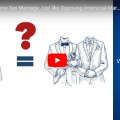Last June, just days before the U.S. Supreme Court struck part of the federal Defense of Marriage Act, sociologists at Rice University published a significant study examining Americans’ attitudes toward same-sex marriage.
The study polled 1,300 random adults in 2006, asking them “The only legal marriage should be between one man and one woman. Agree? Neither Agree nor Disagree? Or Disagree?”
The folks conducting the study then polled the very same group of Americans 6 years later, asking them the same question.
The results were that in 2006, 57% of people said marriage ought to be the union of one man to one woman. In 2012, 53% of people agreed that’s how marriage ought to be defined. On its face, then, this study would seem to indicate support for traditional marriage fell by 4% from 2006 to 2012. That simply is not the case.
By polling the same group of people both times–as opposed to two different, random groups of people–Rice was able to see how individuals shifted on the issue of marriage during those six years. They found that some people who supported traditional marriage in 2006 changed their minds by 2012, but many people who supported same-sex marriage in 2006 actually came to support traditional marriage by 2012.
As the survey’s authors note, “the survey found that over one-quarter (28%) of people who disagreed with the statement [that marriage ought to be one man to one woman] in 2006 agreed with the statement in 2012. So among those respondents agreeing or disagreeing in 2006, more actually switched to agree than to disagree.”
In other words, from 2006 to 2012, if a person was going to change their mind on the issue of marriage, they were more likely to swing toward opposing same-sex marriage than supporting it.
The net result is no major change on the issue of same-sex marriage. Some people support it; most oppose it; a few people change sides; but the final statistics are essentially the same.
The study also found that regardless of how their state laws defined marriage, in 2012, 54% of respondents agreed marriage should be one man to one woman, about a third disagreed, and the remainder were uncertain. As the authors noted, “this finding…suggests that how marriage is legally defined across the states has little to do with actual public opinion, and more to do with higher-level political debates and special interest groups.”
Is Same-Sex Marriage Inevitable?
All of this contradicts the narrative being pushed right now that same-sex marriage is gaining momentum and is “inevitable.” So what do we make of this study–and can we trust it?
This study is significant because it goes a step farther than others. Rather than look at a random smattering of people at one moment–like other studies–it examines the very same sample of people over the course of several years. That lets us see how specific individuals are shifting on the marriage debate–and, as the study highlights, it isn’t all supporters of traditional marriage switching sides.
Additionally, some have alleged polling done by other groups primes respondents to answer in support of same-sex marriage by leading with questions about the legality of same-sex relationships or benefits for same-sex couples. Getting people to answer “yes” to a broad question on the subject may make them more likely to answer “yes” on a more specific question.
A Country More Deeply Divided
The Rice study also points out America is becoming more divided–not less–on the topic of same-sex marriage.
For instance, in 2006, Rice found religious people generally opposed same-sex marriage while non-religious people generally supported it. Today, however, if you attend religious services weekly, you are less likely to support same-sex marriage than you were in 2006. By contrast, if you do not attend religious services at all, you are more likely to support same-sex marriage today than in 2006.
The bottom line: Divisions that already existed have simply become more pronounced over the past seven years. Religious people are more likely than ever to oppose same-sex marriage, according to this study. Non-religious people are less likely.
Conclusion
There’s no doubt a serious battle for the hearts and minds of Americans is going on–and there is plenty at stake. There’s also no doubt people trying to redefine what marriage is have made some major strides at the ballot box and in the court room. The situation is not as obvious, however, as many would have us believe.
The current narrative taking place on same-sex marriage oversimplifies what is occurring. People who support same-sex marriage would have folks believe momentum is swinging 100% their direction, and that same-sex marriage is a forgone conclusion the rest of the country should just accept. The truth is much more complicated than that.
One thing can certainly be gleaned from the trends presented in this study: The debate over what is and is not a marriage won’t be going away any time soon.




